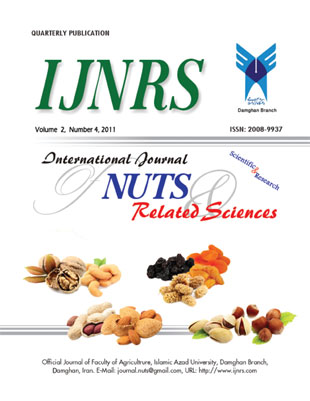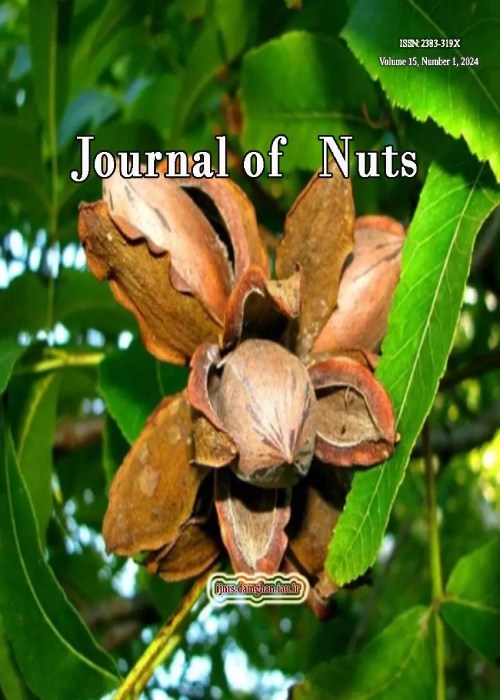فهرست مطالب

Journal of Nuts
Volume:2 Issue: 4, Autumn 2011
- تاریخ انتشار: 1391/02/15
- تعداد عناوین: 8
-
-
Pages 1-14Peanuts (Arachis hypogea L.) are important substrates for the growth and subsequent aflatoxin production by different members of Aspergillus. The aims of the current study were to identify the toxigenic fungi associated with peanut and to study the effect of ozone gaseous (O3) on fungal spoilage and aflatoxin concentration in peanuts. Peanut samples were collected from three Egyptian governorates i.e. Sharkia, Cairo and Ismailia during winter season of 2007. Peanut samples were exposed to O3 at doses of 20 ppm for 5 min, 40 ppm for 10 min and 50 ppm for 5 min. Total fungal counts were estimated in ozonated and non-ozonated peanuts shells and seeds using tow different media and aflatoxin concentration was determined in the ozone treated and non-treated peanuts. The results indicated that all the shell and seed samples were infected with fungi and the samples from Sharkia were the most infected while contained the highest total fungal counts followed by the samples collected from Cairo governorate. Aspergillus flavus was isolated from all seed samples but did not isolated from peanut shells. Exposure to O3 gaseous was effective to reduce total fungal counts in a dose dependent manner and succeeded to eliminate A. flavus in seed samples. All seed samples were contaminated with aflatoxin and O3 at 40 ppm for 10 min succeeded to degrade aflatoxin in peanut seeds to reach the maximum level set in the Egyptian standards regulation.Keywords: Peanut, Fungi, Mycotoxins, Antifungal, Ozone, Egypt
-
Pages 15-24Pistachio nut has high nutritional value. The fat and protein are the common part of pistachio. Major part (about 88%) of the fat content of pistachio includes unsaturated fatty acids. Unsaturated fatty acids are known to have positive effects on human health like preventing to heart diseases. This research has evaluated protein, fat and fatty acids content of some commercial pistachio cultivars of Damghan, Iran namely Akbari, Kaleghoui, Khanjari, Abasali and Shahpasand. The results showed protein and fat contents in studied pistachio cultivars varied from 16.2654 % (Shahpasand) – 20.7025 %(Abasali) to 52.4840 (Shahpasand) – 60.6470%(Akbari), respectively. Regarding of protein and fat there have been significant differences between cultivars. The composition of fatty acids were determined as myristic (0.0810- 0.1080%), palmitic 10.2275- 11.10750%), stearic (1.1010- 1.2700%),arashidic (0.3855- 0.6300%), palmitoleic (0.8175- 1.0180%), oleic (48.9615- 55.2435%), linoleic (30.4820- 36.8840%),linolenic(0.3590- 0.8405%). Oleic acid has been found as the most common monounsaturated fatty acid. Linoleic acid has the highest percentage among polyunsaturated fatty acids. There have been significant differences among pistachio cultivars regarding unsaturated fatty acids. The ratio of unsaturated fatty acids to saturated ones has changed between 6.7- 7.4Keywords: Fat, Fatty Acid Composition, Pistachio Cultivar, Protein
-
Pages 25-32Increase in the exchange rate may not always promote export of non-oil production and exports of various goods; rather they might have different reactions to the exchange rate. Hence, in this study we tried to examine the effect of real effective exchange rate on Iranian pistachio export. The required data were collected from statistical yearbook of Iran's foreign trade, statistical yearbook of the International Monetary Fund, United Nations Food and Agriculture Organization, and various publications of the central bank of Iran for the period of 1974-2008. The results showed that the real effective exchange rate, income of importer countries and domestic production have positive effects on export of pistachio but the effect of the domestic price index to the global pistachio export price index ratio was negative. Hence, it is recommended in order to produce more the crop as well as reduce the domestic price adopted employing advanced production& processing methods, extending the cultivation levels and improving the performance per hectare so that promote the ways of pistachio export.Keywords: Real Effective Exchange Rate, Non, oil exports, Pistachio, Iran
-
Pages 33-36In this study the artificial pollination of pistachio was investigated. Two types of pollen of local selective genotypes (Q1 and Q2) which were different pollinizers were used. The experiment had six treatments. Qazvini and Ohadi cultivars were pollinated with supplementary pollinations as treatment which was covered with cotton bag, natural pollination as a control which was not covered and two types of pollen of local selective genotypes (Q1 and Q2) which were prepared. Results showed that supplementary pollination had positive effects on fruit number per cluster and reduction of blank percentage. Supplementary pollination not only increased quantitative traits (Number of nut per cluster, Kernel dry weight and yield), but also it improved some qualitative traits such as unsplit nut percentage and reduced blank nut percentage in Qazvini and Ohady cultivars.Keywords: Supplementary Pollination, Fruit Set, Pistachio vera
-
Pages 37-54Consumer's awareness about the nutritional profile of their diets has made the industry to respond their needs seriously. In this study, response surface methodology was used to analyze the effect of three fat replacers and two sweeteners on sensory attributes and viscosity of low- calorie pistachio butter. Balangu seed extract (BSG) (0.01-0.04), Reihan seed gum (RSG) (0.01-0.023), xanthan (0.06-0.1), isomalt (0-1) and sucrose (0.25-1) were the levels investigated. A central composite design was used to develop models for the responses. The optimum levels of ingredients according to the target values were as follows: xanthan (0.1%), isomalt: pistachio paste ratio (0.81), sucrose: pistachio paste ratio (0.71) for formulas prepared using xanthan gum; Balangu seed extract (0.034%), isomalt: pistachio paste ratio (1) and sucrose: pistachio paste ratio (0.25) for products containing Balangu seed extract; and RSG (0.023%), isomalt: pistachio paste ratio (0.333) and sucrose: pistachio paste ratio (1.0) for formulas prepared by RSG.Keywords: Pistachio butter, Reduced, calorie, Fat replacers, RSM, Optimization, sensory
-
Pages 55-66On 16th of March 2008, temperature decreased to -6ºC in some parts of the Kerman pistachio plantation area that was caused the heavy damage to pistachio growers. After the damage, some rootstocks were resistance to this temperature and no damage was interned to them. In the present study five rootstocks of resistant and five rootstocks of susceptible to frost damage were selected and evaluated from physiological point of view in order to found physiological parameter that affected on resistance. In May 2010 some samples were got from leaves of both resistant and susceptible rootstocks and were measured in laboratory condition proline, soluble sugars, proteins, nutrient elements including potassium, magnesium, calcium, phosphorus, iron, zinc, copper, manganese. The results showed that no significant differences were observed in content of soluble sugars, proline among resistant and susceptible rootstocks. However, rootstock No. 4 of resistant rootstocks had greatest Magnesium uptake in compare to susceptible rootstocks and rootstock No. 3 of resistant rootstocks had greatest protein and potassium content in compare to susceptible rootstocks. Rootstocks in amount of other elements did not show much difference. As a conclusion the possibility frost damage resistance back to the soluble protein, potassium and magnesium and had a role in resistance to frost damage in pistachio.Keywords: Resistance, Proline, Frost Damage, Nutrient Elements, Soluble Sugars, Protein
-
Pages 67-74Plants are often subjected to several environmental stresses throughout their life cycle. Adaptation of plants to saline conditions may be due to some salt-related changes in the pattern of gene(s) expression. The physiological role of stress induced proteins is not yet clearly understood. However, it is believed that these proteins allow plants to produce biochemical and structural adjustments which enable them to adapt with the stress conditions. In this research we compared protein profile of 4 female cultivars and 2 male genotypes of Rafsanjan Pistachio in salt stress situation. The treatments were irrigated with saline water (EC = 5.5 dSm-1), without drainer, until appearing leaf phytotoxicity. Before and after saline stress leave proteins were extracted by using Damerval method, with some modification. The amount of total proteins was determined according the method of Bradford assay by used of BSA as standard solution. After uniformity of protein concentration, they were loaded on SDS-PAGE, in 12.5% separating gel and 5% stacking gel according to the method of Hames and Rickwood,. The results revealed that salinity induced changes in protein pattern and decreasing of total proteins in leaves of Pistachio. Some bands were decreased, increased, appeared or disappeared after salinity. Additionally a 40 KDa (kilo Dalton) band was increased in all samples. Moreover, this investigation reported the molecular weights of some salt responsive proteins.Keywords: Protein profile, Pistachio, Salt stress, Protein extraction
-
Pages 75-81Walnut Anthracnose is among the major diseases of walnut trees in Qazvin Province which is scattered as an epidemic disease in the recent years. This research is designed to study and comparison of control methods of Anthracnose disease in walnut trees of Roodbar region. After selecting the infected garden and implementing winter and spring spraying treatments, winter spraying treatment and control treatment (which was only gathering of infected leaves and fruits), we counted the infected leaves and fruits in four geographical directions and calculated the percentage of infection; and finally the results were attained after statistical analysis. Winter spraying treatment with Bordeaux solution and spring spraying treatment with coppercontaining compounds showed the maximum effects and minimum infection of leaves and fruits. Meanwhile, northward branches showed the maximum infection among all geographical directions.Keywords: Gnomonia leptostyla, Walnut, Pathogenicity, Spraying treatments


